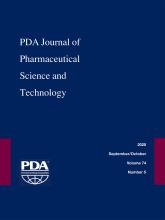Article CommentaryCommentary
Probable Scenarios of Process Contamination with Cutibacterium (Propionibacterium) acnes in Mammalian Cell Bioreactor
Angel L. Salaman-Byron
PDA Journal of Pharmaceutical Science and Technology September 2020, 74 (5) 592-601; DOI: https://doi.org/10.5731/pdajpst.2019.010710
Angel L. Salaman-Byron
Janssen Biotech Inc., 200 Great Valley Parkway, Malvern PA 19355

References
- 1.↵American Society of Mechanical Engineers. ASME BPE-2016: Bioprocessing Equipment. ASME: New York, 2016.
- 2.↵
- Junker B.,
- Lester M.,
- Leporati J.,
- Schmitt J.,
- Kovatch M.,
- Borysewicz S.,
- Maciejak W.,
- Seeley A.,
- Hesse M.,
- Connors N.,
- Brix T.,
- Creveling E.,
- Salmon P.
- 3.↵
- Suvarna K.,
- Lolas A.,
- Hughes P.,
- Friedman R.
- 4.↵
- Blackwell J.
- 5.↵
- Kirschbaum J. O.,
- Kligman A. M.
- 6.↵
- 7.↵
- 8.↵
- Scholz F. P.,
- Kilian M.
- 9.↵
- 10.↵
- Dréno B.,
- Pécastaings S.,
- Corvec S.,
- Veraldi S.,
- Khammari A.,
- Roques C.
- 11.↵
- Acherman Y.,
- Goldstein E. J.,
- Coenye T.,
- Shirtliff M. E.
- 12.↵
- Kvich L.,
- Jensen P. Ø.,
- Justesen U. S.,
- Bjarnsholt T.
- 13.↵
- Kumar B.,
- Pathak R.,
- Bertin Mary P.,
- Jha D.,
- Sardana K.,
- Gautam H. K.
- 14.↵
- Gallo R. L.,
- Nakatsuji T.
- 15.↵
- Costello E. K.,
- Lauber C. L.,
- Hamady M.,
- Fierer N.,
- Gordon J. J.,
- Knight R.
- 16.↵
- Bojar R. A.,
- Holland K.T.
- 17.↵
- 18.↵
- Jahns A. C.,
- Alexeyev O. A.
- 19.↵
- 20.↵
- Nielsen P. A.
- 21.↵
- Tax. G.,
- Puskás R.,
- Kónya Z.,
- Biró T.,
- Kemény L.,
- Szabó K.
- 22.↵
- Shu M.,
- Kuo S.,
- Wang Y.,
- Jiang Y.,
- Liu Y.-T.,
- Gallo R. L.,
- Huang C.-M.
- 23.↵
- 24.↵
- Portillo E. M.,
- Corvec S.,
- Borens O.,
- Trampuz A.
- 25.↵
- Midgley M.,
- Mohd Noor M. A.
- 26.↵
- Faille C.,
- Jullien C.,
- Fontaine F.,
- Bellon-Fontaine M.-N.,
- Slomianny C.,
- Benezech T.
- 27.↵
- Knobben B. A. S.,
- van der Mei H. C.,
- van Horn J. R.,
- Busscher H. J.
- 28.↵
- 29.↵
- Salaman-Byron A. L.
- 30.↵
- Schneider M.,
- Marison I. W.,
- von Stockar U.
- 31.↵
- Dréno B.
- 32.↵
- Tyner H.,
- Patel R.
- 33.↵
- 34.↵
- Li G.,
- Tam L.-K.,
- Tang J. X.
- 35.↵
- Cheung Y. F.,
- Fung C. H.,
- Walsh C.
- 36.↵
- Onadipe A.,
- Ulvedal K.
- 37.↵
- 38.↵
- 39.↵
- Jagani H.,
- Hebbar K.,
- Gang S. S.,
- Raj P. V.,
- Rao J. V.
- 40.↵
- Sandle T.,
- Saghee M.R.
- 41.↵
- Dubiel R.,
- Vogel J. D.
- 42.↵
- Suvarna K.,
- Lolas A.,
- Hughes P.,
- Friedman R.
- 43.↵
- Sutton S.
- 44.↵
- Moldenhauer J.
- 45.↵
- McCullough K. Z.,
- Moldenhauer J.
- McCullough K. Z.,
- Moldenhauer J.
- 46.↵
- Gilles N. T.,
- Marty E.,
- Roesti D.,
- Staerk A.,
- Goverde M.
In This Issue
PDA Journal of Pharmaceutical Science and Technology
Vol. 74, Issue 5
September/October 2020
Probable Scenarios of Process Contamination with Cutibacterium (Propionibacterium) acnes in Mammalian Cell Bioreactor
Angel L. Salaman-Byron
PDA Journal of Pharmaceutical Science and Technology Sep 2020, 74 (5) 592-601; DOI: 10.5731/pdajpst.2019.010710
Jump to section
Related Articles
- No related articles found.
Cited By...
- No citing articles found.





